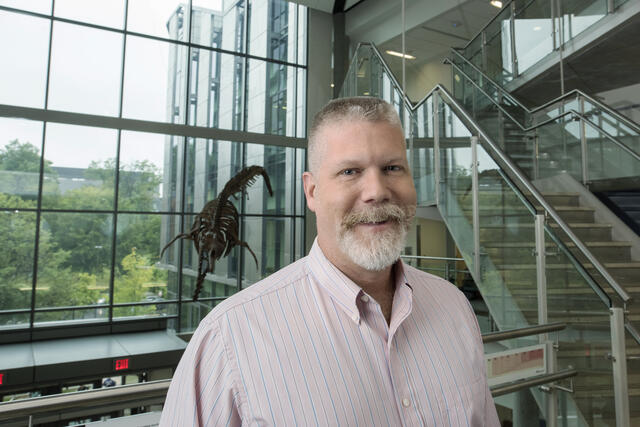Admission CTAs
Mark D. Uhen named new Chair of Department of Atmospheric, Oceanic and Earth Sciences
Mark D. Uhen was recently named Chair of the Department of Atmospheric Oceanic and Earth Sciences (AOES) at George Mason University. Uhen, a paleontologist, and global whale fossil expert, had served as the department’s first Assistant Chair since 2017.
Uhen received his BS in Geology with a minor in Biology from the University of Wisconsin-Oshkosh and his Masters and PhD in Geology from the University of Michigan, Ann Arbor. An active instructor, graduate student and post doc advisor, and researcher since joining Mason in 2009, Uhen’s student coursework includes topics such as Evolution and Extinction, Introductory Geology, Historical Geology, Environmental Geology, and Vertebrate Paleontology.
Uhen’s extensive field experience has taken him from dinosaur formation research in Bighorn Basin in Wyoming, to examining Middle and late Eocene archaeocite whales of Louisiana, Alabama, Mississippi, and South Carolina, and even to the Pisco basin Peru and Western Sahara.
With career grant support totaling more than $3.5 million, Uhen currently has over 86 peer reviewed publications, 89 published abstracts, and 5,000 citations. He serves as lead investigator on a National Science Foundation funded collaboration to establish a comprehensive paleobiology database which will create the standard for preserving and presenting ancient data for future research.
Uhen actively engages with many professional societies and publications including the Society of Vertebrate Paleontology, the Paleontological Society, as well as on the Elements of Paleontology Editorial Board.
Prior to his arrival at Mason, Uhen served as Curator of Paleontology for the Alabama Museum of Natural History, was a Senior Postdoctoral Fellow in the Smithsonian’s National Museum of Natural History, and also spent a decade with the Cranbrook Institute of Science, most notably as its Head of Research and Collections
Uhen, who succeeds James Kinter in the role, stated “Jim and I have worked to advance our Geology Program in terms of adding new faculty, growing the undergrad and graduate student populations, and adding new courses and programs.”
Enrollment in Mason’s AOES courses experienced double-digit growth in 3 out of the past 4 years. And research productivity remains high.
“Over the past few years, Kinter and Uhen focused together on a growth mission for our AOES department, expanding academic offerings along with the department’s faculty expertise, most notably at the graduate level,” said College of Science Dean, Fernando Miralles-Wilhelm who is also AOES faculty. “AOES is definitely one of Mason’s nationally regarded programs of note and I look forward to seeing Mark and his team continue the current trajectory,” Miralles-Wilhelm added.
When asked about his future plans as chair, Uhen highlighted his goals to add a Geology PhD, while hiring new faculty in both climate and geology, to keep up with the department’s expanding student population and research portfolio.
“I also look to continue enhancing the diversity of the department and our communication and outreach with the general public,” Uhen explained.
James Kinter, who came to Mason in 1996, full-time in 2014, had served as AOES Department chair for the past four years as well as Director of Mason’s Center for Ocean-Land-Atmosphere Studies for the past seven years.
During his term as chair, Kinter oversaw the addition of a new degree program (MS Climate Science), as well as three hires and three promotions of tenure line faculty, resulting in an increase in the tenure line female faculty proportion from 15 percent to 27 percent and the instructional female faculty proportion increased from 29 percent to 35 percent.

